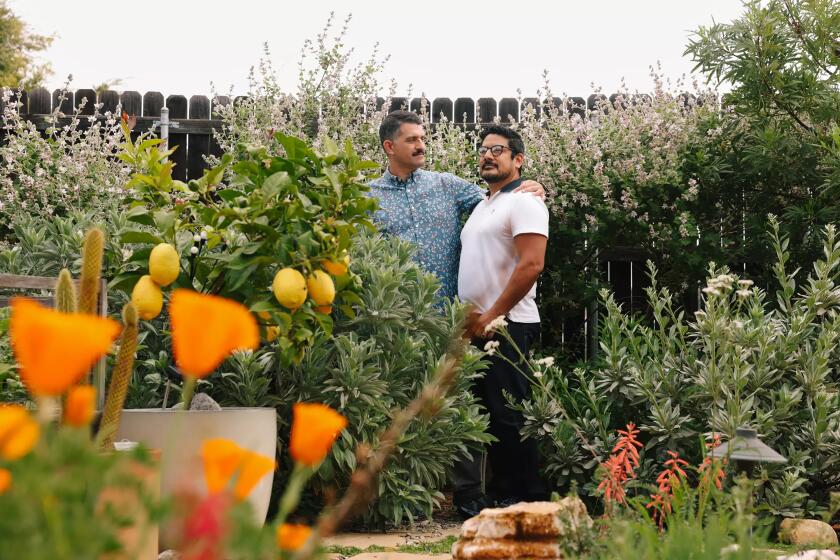Two worlds of succulents
Beautiful and sculptural; these are two terms often used to describe both aloes and agaves. Aloes and agaves are two groups of succulents that do extremely well in our hot climate, with little or no irrigation. While these plants make great contributions to our gardens, home gardeners often have trouble distinguishing between the two.
Aloe is a very large genus of plants. There are more than 500 species of aloe, all from the Old World, which refers to the Eastern Hemisphere. Most are native to Africa, Madagascar, islands in the Indian Ocean, and the Arabian Peninsula.
Aloes are evergreens whose very fleshy succulent blades are arranged in rosettes. Those rosettes can be as small as a starfish (Aloe ‘Christmas Carol’) or 4 to 6 feet across (Aloe dyeri), though most aloes you see in gardens are closer to a foot or two across (Aloe spinosissima). There are low-growing, “ground cover” aloes (Aloe nobilis), clumping shrublike aloes (Aloe speciosa), a few trailing aloes that grow like vines (Aloe ciliaris), and some tall, treelike aloes (Aloe barberae), whose leafy rosettes are perched atop tall, corky trunks.
Many aloes are smooth-bladed with blunt or pointed (not necessarily sharp) blade tips (Aloe bracteosa). The blades of some species are edged with large teeth (Aloe marlothii). A few, such as Aloe ferox, feature spines on the blade surfaces, too.
Aloe blades can be very colorful. Most are greenish or bluish blades, but one of my favorites, Aloe rubroviolaceae, has teal-colored leaves that blush lavender. While variegated aloes are striped (Aloe ‘Splashy Lassie’), others are spotted or patterned (Aloe duckeri) or striated (Aloe striata). Their teeth can be red or orange (edging a blue or green blade), and in winter cold, bright sun, extreme heat or when water stressed, some aloe species turn orange, copper or red. The blades of Aloe cameronii, for example, take on a beautiful, deep terra-cotta color.
Flowers are the most distinctive aloe features. Aloe flowers are always intensely colored. Whether orange, coral, yellow or red, aloe flowers are usually pendent, meaning that the “mouths” of these tube-shaped flowers point down. Flowers, then, are oriented perfectly for a visit from a hungry hummingbird.
Aloe flowers can be arranged in a number of ways, most typically as poker-shaped clusters at the ends of single or multiple branched flower stalks (Aloe marlothii). Before the flowers open, the buds hold tightly against the stalk. When they open, they start from the bottom and open upward in sequence. Sometimes, the buds are one color while the flowers are another. As the buds open, they create a two-tone effect (Aloe speciosa).
Many aloes bloom right about now, which is part of what makes them such great garden plants since winter blooming flowers are scarce. Still, some aloes bloom in late spring while others bloom in summer.
Agave is also a large genus of plants. There are more than 200 species of agave, all from the New World, the Western Hemisphere, primarily Mexico, Southwestern U.S. and down through Central America into South America.
Agaves are evergreens whose often leathery, succulent blades are arranged in rosettes. Those rosettes can also be as small as a starfish (Agave filifera ssp microceps) or 6 to 8 feet tall and wide (Agave americana), though most agaves you see in gardens are closer to 2 or 3 feet across (Aloe guiengola). Only a few agaves are single rosettes (Agave bracteosa). Instead, most send out pups that eventually create low clumps. A few agave species form short trunks with leafy rosettes perched at the top (Agave attenuata).
While some agaves are smooth-bladed, most have sharp, pointed tips and teeth that you don’t want to bump into (Agave bovicornuta).
Agave blades are typically shades of blue, silver or green (Agave attenuate, Agave attenuate ‘Nova,’ Agave ‘Blue Flame,’ Agave americana and others). Leaves don’t turn orange or red, though some agaves have reddish blade margins (Agave ‘Blue Glow’). Variegated agaves are striped blue or green with cream or yellow (Agave angustifolia ‘Marginata’ or Agave americana var marginata).
One really interesting characteristic of agave blades is their tendency to be embossed. When you look inside of an agave blade, you can see the embossed impression of the blade it was pushing up against. On the outside of the blade, you can see the embossed impression of the blade that was pushing up against it. This embossing is not seen in aloes.
Agave flower stalks are distinctive, though flowers are not. Agave flower stalks rise from the center of the rosette. As they climb skyward, they usually look like giant stalks of asparagus (an agave relative). Some species form single stalks, some branching stalks. Either way, flower stalks can be two or three times the height of the agave rosettes. Nearly all agave plants die after they finish flowering.
Agaves with branching flower stems tend to have white, cream or pale yellow flowers. Those flowers make generous amounts of nectar that smells like ripe or fermenting fruit. The fragrance attracts bat pollinators, who visit in the dark. These agaves are also pollinated by hawkmoths and other insects.
Agaves with straight flower stalks have yellow to bright yellow flowers to attract daytime pollinators like bees and hummingbirds.
While aloes bloom reliably every year, agaves bloom only occasionally and not predictably.
That said, it might take a few years for an agave flower stalk to fully develop and for flowers to appear, then fade. As flowers fade, some species of agave (Agave desmettiana) form bulbils, tiny plants that are clones of the mother plant. As the flower stalk leans earthward, the bulbils fall to the ground, and some root. The mother plant then dies.
Whether having made seeds or bulbils, agaves leave a legacy of pups behind.
Now, think you can tell the difference between aloe and agave?
Get U-T Arts & Culture on Thursdays
A San Diego insider’s look at what talented artists are bringing to the stage, screen, galleries and more.
You may occasionally receive promotional content from the San Diego Union-Tribune.





